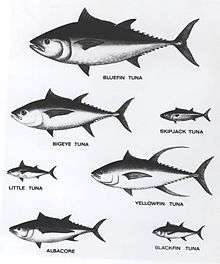鮪
See also: 鲔
| ||||||||
Translingual
Han character
鮪 (radical 195, 魚+6, 17 strokes, cangjie input 弓火大月 (NFKB), four-corner 24327, composition ⿰魚有)
- kind of sturgeon,
References
- KangXi: page 1469, character 21
- Dai Kanwa Jiten: character 46126
- Dae Jaweon: page 2002, character 18
- Hanyu Da Zidian: volume 7, page 4685, character 9
- Unihan data for U+9BAA
Chinese
| trad. | 鮪 | |
|---|---|---|
| simp. | 鲔 | |
Glyph origin
| Characters in the same phonetic series (又) (Zhengzhang, 2003) | |
|---|---|
| Old Chinese | |
| 絠 | *kɯːʔ |
| 醢 | *qʰɯːʔ |
| 珛 | *qʰʷɯs |
| 栯 | *ɢʷɯʔ, *qʷɯ |
| 有 | *ɢʷɯʔ |
| 友 | *ɢʷɯʔ |
| 右 | *ɢʷɯʔ, *ɢʷɯs |
| 宥 | *ɢʷɯs |
| 囿 | *ɢʷɯs, *ɡʷɯ |
| 侑 | *ɢʷɯs |
| 酭 | *ɢʷɯs |
| 姷 | *ɢʷɯs |
| 又 | *ɢʷɯs |
| 佑 | *ɢʷɯs |
| 祐 | *ɢʷɯs |
| 賄 | *qʰʷɯːʔ |
| 蛕 | *qʰʷɯːʔ, *ɡʷɯː |
| 烠 | *ɡʷɯː |
| 倄 | *ɢraːw, *ɢʷɯːʔ |
| 鮪 | *ɢʷɯʔ |
| 洧 | *ɢʷɯʔ |
| 痏 | *ɢʷɯʔ |
| 郁 | *qʷɯ |
| 戫 | *qʷɯ |
| 哊 | *ɡʷɯ |
Pronunciation
Japanese
Readings
- Go-on: い (i)←ゐ (wi, historical)
- Kan-on: い (i)←ゐ (wi, historical)
- Kan’yō-on: ゆう (yū)←いう (iu, historical)
- Kun: まぐろ (maguro, 鮪); しび (shibi, 鮪)
Noun
鮪 (hiragana まぐろ, katakana マグロ, rōmaji maguro)
- a tuna (fish of the genus Thunnus)
- マンガで分かるLisp (Manga Guide to Lisp)
- みりん。地域猫。最近までマクロのことをマグロと思っていた。
- Mirin. Chiikineko. Saikin made makuro no koto o maguro to omotteita.
- Mirin: A neighbours' cat. Until recently often confused macros with tuna.
- みりん。地域猫。最近までマクロのことをマグロと思っていた。
- Hypernym: 鯖 (saba)
- マンガで分かるLisp (Manga Guide to Lisp)
- (colloquial) Short for 黒鮪 (kuromaguro): a Pacific bluefin tuna, Thunnus orientalis
- (slang) a dead fish
Usage notes
As with many terms that name organisms, this term is often spelled in katakana, especially in biological contexts, as マグロ.
Derived terms
Derived terms
- 鮪茶 (magucha)
- 磯鮪 (isomaguro)
- インド鮪 (Indo maguro)
- 梶木鮪, 旗魚鮪 (kajiki maguro)
- 黄肌鮪 (kihada maguro), 黄肌鮪 (kiwada maguro)
- 黒鮪 (kuromaguro)
- 五島鮪 (Gotō maguro)
- 塩鮪 (shiomaguro)
- 畜養鮪 (chikuyō maguro)
- 葱鮪 (negima)
- 畑鮪 (hatamaguro)
- 鬢長鮪 (binnaga maguro)
- 本鮪 (honmaguro)
- 南鮪 (minami maguro)
- めじ鮪 (mejimaguro)
Idioms
- 鮪を抱いて寝たよう (maguro o daite netayō)
See also
- 黄肌 (kihada, “yellowfin tuna”)
- 鬢長 (binnaga, “albacore”)
- 目撥 (mebachi)
- とろ (toro)
Noun
- (obsolete) a tuna
- 711–712, Kojiki (poem 110)
- 意布袁余志斯毘都久阿麻余斯賀阿禮婆宇良胡本斯祁牟斯毘都久志毘 [Man'yōgana]
- 大魚よししび突く海人よ其が離ればうら恋ほしけむしび突く志毘 [Modern spelling]
- ouo yoshi shibi tsuku ama yo shi ga areba uragōshikemu shibi tsuku Shibi
- (please add an English translation of this example)
- Antonym: めじ (meji)
- 711–712, Kojiki (poem 110)
Derived terms
- 鮪節 (shibibushi)
- 糸鮪 (itoshibi)
- 蜻蛉鮪 (tonboshibi)
See also
- 大魚よし (ouo yoshi, pillow word alluding to shibi)
Derived terms
- 鮪の身 (hatsu no mi)
Korean

Relative sizes
This article is issued from
Wiktionary.
The text is licensed under Creative
Commons - Attribution - Sharealike.
Additional terms may apply for the media files.